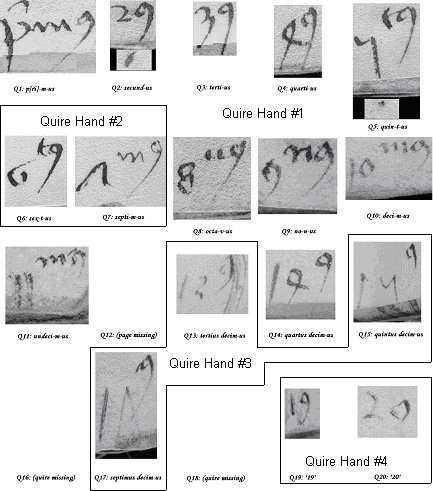For ages, I’ve been planning to devote a day at the British Library solely to the task of looking for matches for the Voynich Manuscript’s unusual quire numbers. There’s a long description of these quire numbers elsewhere on this website, but the short version is that they are “abbreviated longhand Latin ordinals in a fifteenth century hand”, and are one of the key things that point directly to a 15th century date:-

If we could find any other manuscripts with this same numbering scheme (or possibly even the same handwriting!), it would be an extraordinarily specific way of pinning down the likely provenance of our elusive manuscript, more than a century before its next mention (circa 1610). It would also give an enormous hint as to the archive resources we should really be looking in to find textual references to it.
But let’s not get too carried away – how should we go about finding a match, bearing in mind we haven’t even got one so far?
To achieve this, my (fairly shallow, I have to say) research strategy is to trawl through the following early modern palaeography source books, as kindly suggested by UCL’s Marigold Norbye:-
- F. Steffens, Lateinische Paläographie (Berlin and Leipzig, 1929)
- New Palaeographical Society Facsimiles of Manuscripts &c., ed. E.M. Thompson, G.F. Warner, F.G. Kenyon and J.P. Gilson, 1st er. (London, 1903-12); 2nd ser. (London, 1913-30)
- Palaeographical Society Facsimiles of Manuscripts and Inscriptions, ed. E.A. Bond, E.M. Thompson and G.F. Warner, 1st ser. (London, 1873-83); 2nd ser. (London, 1884-94)
- S.H. Thomson, Latin Bookhands of the Later Middle Ages (Cambridge, 1969)
- G.F. Hill, The Development of Arabic Numerals in Europe exhibited in sixty-four Tables (Oxford, 1915)
- Catalogue des manuscrits en écriture latine portant des indications de date, de lieu ou de copiste, by Charles Samaran and Robert Marichal. etc.
To which I would add (seeing as it was written by Michelle Brown, who was for many years the Curator of Medieval and Illuminated Manuscripts at the British Library, so it seems a little ungracious not to include it)…
- Brown, Michelle. A Guide to Western Historical Scripts: From Antiquity to 1600. London : British Library, 1990.
…as well as the Italian equivalent of Samaran and Marichal’s work…
- Catalogo dei manoscritti in scrittura latina datati o databili per indicazione di anno, di luogo o di copista. Torino, Bottega d’Erasmo, 1971 Bird-Special Collections Z6605.L3 C38 f
…and a more general bibliographical reference work…
- Boyle, Leonard E. Medieval Latin Palaeography: A Bibliographical Introduction. Toronto: University of Toronto Press, 1984.
Even though this might seem like a very large set of source books to get through in a day, no more than 5-10% of each is likely to be acutely relevant to the 15th century, so it should all be (just about) do-able. And I think that several of them may well be on open shelves in the Rare Books & Manuscripts Room at the BL, which should help speed things along.
Yet all the same, do I stand any significant chance of uncovering anything? Well… no, not really, I’d have to say. But that’s no reason not to try! And the bibliographic side of the trawl may well yield a more specific lead to follow in future, you never know.
All I need to do, then, is to free up an entire day from my diary… oh well, maybe next year, then. =:-o
Don’t know if the following are any use –
ADD 56274 – in the back of this is a small modernish printed pamphlet that gives – History of Individual letters / Runes / Abbreviations
ROYAL MS 12BXXV f.283 14th ? century – is a table giving English numbers & their Latin equivalents in an old style
Tony
Also try
Andrew Watson
Catalogue of dated and datable manuscripts, c. 700-1600, in the Department of Manuscripts, the British Library: London, 1979
Catalogue of dated and datable manuscripts c. 435-1600 in Oxford libraries: Oxford, 1974
and others in this series.
I have copies of a couple of these and will take a look and see if the above mentioned quire numbers are featured in any of them.
Please note that there’s an online edition of Franz Steffens “Lateinische Paläographie” in french (Paléographie latine — Trèves, Paris , 1910) available at:
http://www.archivi.beniculturali.it/Biblioteca/indexSteffens.html
Some others that you may find interesting are :
— “Scriptura Latina Libraria”
“Scriptura Gothica Libraria” both by Joachim Kirchner
— “Paleography of Gothic Manuscript Books”
by Albert Derolez
I’ve been studying these and other books in an attempt to pin down the approximate date of the marginalia and may have found something of interest — the “single stroke” form of the “X” on 116v seems to be limited to the late decades of the 14th century with other “2 stroke” forms being seen before and after this period. Nothing earthshaking, of course, but a faint signpost to a better transcription/translation and tighter dating.
That’s fascinating, and thanks for the links – but you should remember that f116v does look as though it has been emended. On that third line of f116v, the ink in the “ma+ria” at the end is badly faded (and so I would predict would be original), while many of the letters at the start of the same line (including the “x” letters, unfortunately) seem to have been twiddled around with.
This is one of the pages I proposed to the Beinecke that we should multi-spectral scan, to try to untie this forensic knot – for unless you can separate the layers, how can you date them? The quire numbers have their own problems, of course, but they’re still relatively straightforward compared to f116v. 🙁